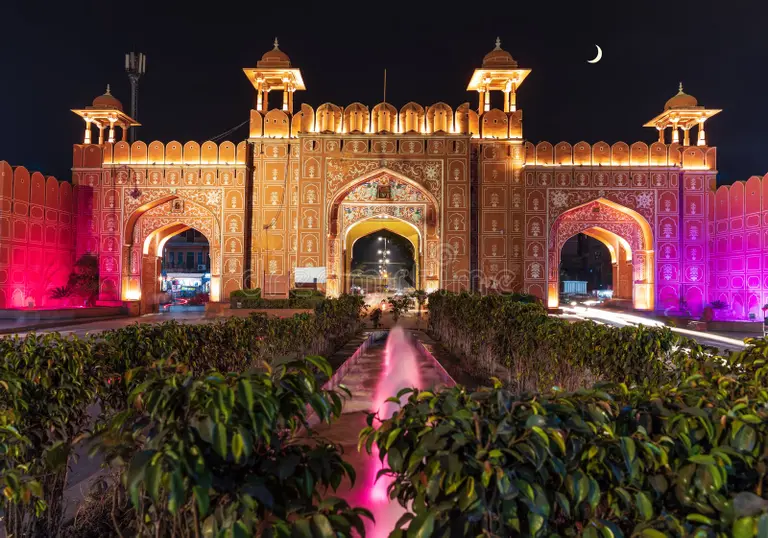Loading...
Historic gateway to the walled city of Jaipur, named after the road leading to Ajmer and featuring traditional Rajasthani architecture..

Ajmeri Gate is one of the most important gateways of Jaipur’s Pink City. Built in 1727 during the reign of Maharaja Sawai Jai Singh II, it has stood as a symbol of history, culture, and architectural brilliance for nearly 300 years. The gate was named after the road that connects Jaipur with Ajmer, a city located about 130 kilometers away and famous for the Ajmer Sharif Dargah and Pushkar. Today, Ajmeri Gate continues to be a vital link between Jaipur’s glorious past and its vibrant present.
When Jaipur was established, the city was enclosed by massive walls and seven gates. Each gate connected Jaipur with nearby regions. Ajmeri Gate was built on the western side of the city to provide direct access to Ajmer. The gate also served as a checkpoint for traders, travelers, and pilgrims entering the walled city. Its design made it both a defensive stronghold and a cultural hub. Historical accounts show that thousands of traders used this gate every year, making it a lifeline for commerce and community life in the 18th century.
The structure of Ajmeri Gate is a fine example of Rajasthani craftsmanship with touches of Mughal style. Built from red sandstone and lime plaster, the gate has grand arches and detailed motifs. The battlements on the top gave it a fortress-like appearance, protecting the city from invasions. The symmetrical layout of the gateway is in line with Jaipur’s famous urban planning, which UNESCO recognized in 2019 when Jaipur was declared a World Heritage City. Restoration efforts by heritage bodies have helped the gate retain its beauty, making it a popular landmark for both locals and visitors.
In present-day Jaipur, Ajmeri Gate is surrounded by lively markets, shops, and street food stalls. The area attracts thousands of people daily. It serves as a connecting point between the old Pink City and the newer parts of Jaipur. Despite the modernization of its surroundings, Ajmeri Gate continues to be an important reference point. The gate is also a favorite starting point for tourists exploring famous bazaars such as Kishanpole Bazaar and Chandpole Bazaar.
The opening of Jaipur Metro has improved access to Ajmeri Gate. The nearest station is Ajmeri Gate Metro Station on the Pink Line. This station connects the walled city with major parts of Jaipur, including Railway Station and Sindhi Camp Bus Stand. Jaipur Metro carries thousands of passengers daily, reducing traffic pressure near heritage sites. For tourists, this metro link offers a convenient and affordable way to visit Ajmeri Gate and the bustling bazaars around it.
The bazaars near Ajmeri Gate are among the busiest in Jaipur. They are known for authentic Rajasthani products and budget-friendly shopping. Visitors can find:
Street food stalls in this area are equally popular. From kachoris and samosas to sweets like ghewar, the local food scene around Ajmeri Gate is a major attraction. The vibrant mix of heritage shopping and authentic cuisine makes this part of Jaipur a favorite for both locals and travelers.
Ajmeri Gate is centrally located, making it a convenient base for sightseeing. Key attractions within walking or short commuting distance include:
These attractions showcase Jaipur’s unique combination of art, history, and tradition. Many visitors prefer to begin their city exploration from Ajmeri Gate due to its prime location.
Ajmeri Gate is a popular spot for photographers, history lovers, and those looking to experience the real essence of Jaipur. The best time to visit is early morning or evening, when the sandstone glows under natural light. Heritage walks often include Ajmeri Gate, where guides share stories of trade, culture, and battles. Exploring the narrow lanes nearby reveals hidden gems such as old havelis, temples, and workshops of traditional artisans.
Ajmeri Gate is one of the most used heritage gates of Jaipur. With the city’s growth, continuous maintenance has become essential. Government and heritage groups have taken up conservation projects to safeguard the structure. Jaipur’s recognition as a UNESCO World Heritage City in 2019 has increased focus on preserving Ajmeri Gate as a symbol of the Pink City. This attention ensures that the gate continues to represent the vision and foresight of its founder Maharaja Sawai Jai Singh II.
Ajmeri Gate is more than a historic gateway. It is a living reminder of Jaipur’s history and cultural pride. From its role as a defense structure in the 18th century to being a commercial and tourist hub today, the gate reflects the city’s journey. Statistics from Jaipur Tourism show that the Pink City attracts over 3 million domestic and international visitors annually, and Ajmeri Gate remains one of the most photographed landmarks. Its blend of history, architecture, and accessibility makes it an unmissable attraction.
If you are planning to explore Jaipur, make sure Ajmeri Gate is part of your itinerary. It offers easy access to local markets, cultural hotspots, and nearby monuments. The gate is not just an entrance; it is the beginning of an authentic Jaipur experience.
Opening Hours
Open 24 hours
Closed On
None (Open all days)
Time Required
15-30 minutes
Best Time to Visit
Daytime for better visibility
Address
Ajmeri Gate, Pink City, Jaipur, Rajasthan 302001